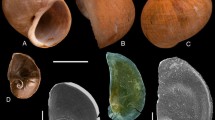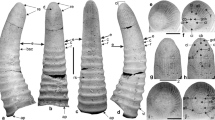Abstract
Cassiduloids are currently rare irregular echinoids with a highly conserved adult morphology. Aristotle’s lantern is present only during the post-metamorphic stage, and little is known about the early development of species in this group. Cassidulus mitis produces eggs of about 375 μm in diameter, lecithotrophic larvae with four reduced arms with skeletal fenestrated rods, cilia along the body surface, and a ciliated band on arms and lobes. Offspring is brooded among the female spines from embryo to settler’s stage. The echinopluteus larval stage is reached 6 days after fertilization, and the settler’s stage is formed at the age of 17 days. Aristotle’s lantern appears around the thirteenth day of development. The lantern is well developed and functional in settlers. It remains until at least 62 days after fertilization and can be used to acquire food from the environment. The early development of C. mitis is unusual concerning features of typical lecithotrophic larvae (such as reduced arms), but retains some features of planktotrophic larvae (such as skeletal rods and a ciliated band). Regarding egg size, early development in C. mitis seems to be transitioning from facultative lecithotrophic to typical obligate lecithotrophic pattern in echinoid larval evolution.






Similar content being viewed by others
References
Albuquerque EF, Genofre GC (1999) Flutuação da população de Microcerberus ramosae (Crustacea: Isopoda) da fauna intersticial da Praia Vermelha, Rio de Janeiro, Brasil. In: Silva SHG, Lavrado HP (eds) Ecologia dos ambientes costeiros do estado do Rio de Janeiro. Série Oecologia Brasiliensis, Rio de Janeiro, pp 229–243
Brennand HS, Soars N, Dworjanyn SA, Davis AR, Byrne M (2010) Impact of ocean warming and ocean acidification on larval development and calcification in the sea urchin Tripneustes gratilla. Plos One 5:1–7
Emlet RB, McEdward LR, Strathmann RR (1987) Echinoderm larval ecology viewed from the egg. In: Jangoux M, Lawrence JM (eds) Echinoderm studies. A A Balkema, Rotterdam, pp 55–136
Emlet RB, Young CM, George SB (2002) Phylum echinodermata: echinoidea. In: Young CM, Sewell MA, Rice ME (eds) Atlas of marine invertebrate larvae. Academic Press, San Diego, pp 531–551
Foltz KR, Adams NL, Runft LL (2004) Echinoderms eggs and embryos: procurement and culture. In: Ettensohn CA, Wessel GM, Wray GA (eds) Development of sea urchins, ascidians, and other invertebrate deuterostomes: experimental approaches. Elsevier Academic Press, San Diego, pp 39–74
Freire CA, Santos PJP, Fontoura NF, Magalhães RAO, Grohmann PA (1992) Growth and spatial distribution of Cassidulus mitis (Echinodermata: Echinoidea) on a sand beach in Southeastern Brazil. Mar Biol 112:625–630
Ghiold J (1988) Species distributions of irregular echinoids. Biol Oceanogr 6:79–162
Gillespie JM, McClintock JB (2007) Brooding in echinoderms: how can modern experimental techniques add to our historical perspective? J Exp Mar Ecol 342:191–201
Gladfelter WB (1978) General ecology of the cassiduloid urchin Cassidulus caribearum. Mar Biol 47:149–160
Hamel JF, Himmelman JH (1992) Sexual dimorphism in the sand dollar Echinarachnius parma. Mar Biol 113:379–383
Hart MW (1996) Evolutionary loss of larval feeding: development, form and function in a facultatively feeding larva, Brisaster latifrons. Evol 50:174–187
Jackson RT (1912) Phylogeny of the echini, with a revision of paleozoi species. Mem Boston Soc Nat Hist 7:1–444
Kier PM (1962) Revision of the cassiduloid echinoids. Smithsonian Misc Collect Wash 114:1–262
Kier PM (1974) Evolutionary trends and their functional significance in the Post- Paleozoic echinoids. J Paleontol 48:1–92
Kier PM (1982) Rapid evolution in echinoids. Palaeontology 25:1–9
Kjerfve B, Ribeiro CHA, Dias GTM, Filipo AM, Quaresma VS (1997) Oceanographic characteristics of an impacted coastal bay: Baía de Guanabara, Rio de Janeiro, Brazil. Cont Shelf Res 17:1609–1643
Krau L (1954) Nova espécie de ouriço do mar: Cassidulus mitis, ordem cassiduloida, echinoidea, capturado na Baía de Sepetiba. Mem Inst Oswaldo Cruz 52:455–475
Lowe CJ, Wray G (2000) Rearing larvae of sea stars for developmental studies. In: Tuan RS, Lo CW (eds) Developmental biology protocols. Humana Press Inc, New Jersey, pp 9–15
MacCord FS, Ventura CRR (2004) Reproductive cycle of the endemic cassiduloid Cassidulus mitis (Echinoidea: Cassiduloida) on the Brazilian coast. Mar Biol 145:603–612
Markel K (1978) On the teeth of the recent cassiduloid Echinolampas depressa Gray, 1851 and on some Liassic fossil teeth nearly identical in structure (Echinodermata, Echinoidea). Zoomorphologie 89:125–144
Maureen DK, Wendy KB, Robert RLG (1988) Microwave treatment for sterilization of phytoplankton culture media. J Exp Mar Ecol 117:279–283
McEdward LR, Miner BG (2007) Echinoid larval ecology. In: Lawrence JM (ed) Edible sea urchins: biology and ecology. Elsevier Science, Amsterdam, pp 71–93
Mooi R (1990a) Living cassiduloids (Echinodermata: Echionidea): a key and annotated list. Proc Biol Soc Wash 103:63–85
Mooi R (1990b) A new “living fossil” echinoid (Echinodermata) and the ecology and paleobiology of Caribbean cassiduloids. Bull Mar Sci 46:688–700
Mooi R (1990c) Paedomorphosis, Aristotle’s lantern and the origin of sand dollars (Echinodermata: Clypeasteroida). Paleobiology 16:25–48
Mooi R, David B (1993) Ontogeny and origin of the brooding system in Antarctic urechinid sea urchins (Echinodermata, Holasteroida). Zoomorphology 113:69–78
Mortensen TW (1948) A monograph of the echinoidea. Holectypoida, Cassiduloida. Compenhagen: Bianco Luno, p 371
Olson RR, Cameron JL, Young CM (1993) Larval development (with observations on spawning) of the pencil urchin Phyllacanthus imperialis: a new intermediate form? Biol Bull 185:77–85
Pearse JS, Cameron RA (1991) Echinoidea. In: Giese AC, Pearse JS, Pearse VB (eds) Reproduction of marine invertebrates, echinoderms and lophophorates, vol 7. The Boxwood Press, Pacific Groove, pp 513–662
Raff RA, Herlands L, Morris VB, Healy J (1990) Evolutionary modification of echinoid sperm correlates with developmental mode. Dev Growth Differ 32:283–291
Schopf TJM (1984) Rates of evolution and the notion of “living fossil”. Annu Rev Earth Planet Sci 12:245–292
Seixas TG, Moreira I, Kehrig HA, Malm O (2007) Distribuição de selênio em organismos marinhos da Baía de Guanabara/RJ. Quim Nova 30:554–559
Smith AB (1984) Classification of echinodermata. Palaeontology 27:431–459
Smith AB (2001) Probing the cassiduloid origins of clypeasteroid echinoids using stratigraphically restricted parsimony analysis. Paleobiology 27:392–404
Smith AB, Jeffery CH (1998) Selectivity of extinction among sea urchins at the end of the Cretaceous period. Nature 392:69–71
Smith MS, Zigler KS, Raff RA (2007) Evolution of direct-developing larvae: selection vs loss. BioEssays 29:566–571
Strathmann RR (1985) Feeding and nonfeeding larval development and life-history evolution in marine invertebrates. Ann Rev Ecol Syst 16:339–361
Tommasi LR, Lima-Verde JS (1970) Observações sobre Cassidulus mitis Krau, 1954 (Cassiduloida, Echinoidea), vol 18. Bol. Climatol Int. Oceanog. Univ. São Paulo, pp 1–9
Wagner PJ (2000) Exhaustion of morphologic character states among fossil taxa. Evolution 54:365–386
Wilson KA, Andrews ME, Turner FR, Raff RA (2005) Major regulatory factors in the evolution of development: the roles of goosecoid and Msx in the evolution of the direct-developing sea urchin Heliocidaris erythrogramma. Evol Dev 7:416–428
Wray GA (1995) Punctuated evolution of embryos. Science 267:1114–1116
Acknowledgments
We are grateful to E M Lopes and F S Viana for their help in laboratory activities and to M S Martins for helping with English. We are also very thankful to John Lawrence, Richard Strathmann and the two anonymous reviewers for their critical comments and suggestions that substantially improved our original manuscript. T Chediak kindly took the photograph of C. mitis (Fig. 1). M Contins was supported by a scholarship from the Center for Research of Petrobras (CENPES/Petrobras) and UFRJ. CRR Ventura thanks to the Brazilian Council of Research (CNPq) for the Research Productivity Fellowship.
Author information
Authors and Affiliations
Corresponding author
Additional information
Communicated by M. Byrne.
Electronic supplementary material
Below is the link to the electronic supplementary material.
Supplementary material 1 (MPG 4264 kb)
Rights and permissions
About this article
Cite this article
Contins, M., Ventura, C.R.R. Embryonic, larval, and post-metamorphic development of the sea urchin Cassidulus mitis (Echinoidea; Cassiduloida): an endemic brooding species from Rio de Janeiro, Brazil. Mar Biol 158, 2279–2288 (2011). https://doi.org/10.1007/s00227-011-1732-5
Received:
Accepted:
Published:
Issue Date:
DOI: https://doi.org/10.1007/s00227-011-1732-5




